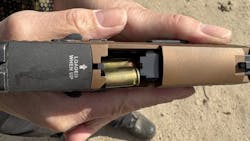Double Feed Stoppage: Tips on How to Fix This Firearm Malfunction
In the September/October 2024 issue of OFFICER Magazine, I talked about clearing malfunctions using the TRT (Tap, Rack, Target) method. The TRT method can clear most malfunctions related to extraction. That is, they can clear Type 1 malfunctions. There are a couple of malfunctions that TRT cannot clear. This article is about Type 2 and Type 3 malfunctions. There are actually 6 types of malfunctions, but we really want to keep it to two drills for most of the things that can go wrong with a gun.
This article appeared in the January/February issue of OFFICER Magazine. Click Here to subscribe to OFFICER Magazine.
A stoppage or a malfunction is when a gun fails to fire. It is usually discovered by the shooter when they press the trigger. Instead of a “bang,” there is a “click,” or nothing at all. Whether it is a mechanical or ammo defect, or even a shooter induced malfunction, it is imperative to get the gun back into business. Every shooter needs to know the basics of Immediate Action, the steps that a shooter takes to restore the gun to shooting condition.
A Type 1 malfunction happens when the gun fails to feed. It is characterized by a round that does not fully seat itself in the chamber. Usually, the slide is stuck slightly to the rear. This type of malfunction is generally cleared by TRT.
A Type 2 malfunction happens when the gun fails to fully extract or eject. Often the brass gets stuck in between the recoil face of the slide and the chamber portion of the barrel, sticking up like a stovepipe. This is commonly called a “stovepipe” malfunction. There are a couple of different strategies for clearing a stovepipe, but Lindsey likes to keep things simple. It’s TRT.
A Type 3 malfunction, commonly called a “double feed,” happens when there is a round in the chamber, and the gun attempts to feed another behind it. When this occurs, the second round is probably not completely stripped from the magazine. Clearing a double feed is different. It requires stripping the magazine from the gun. After that, it is TRT.
More on OFFICER.com
Training Without Scars: Using Tap-Rack-Target Method to Clear Stoppages
- The Springfield Armory XD-M 4.5” C02 Blowback .177 BB Air Pistol is a licensed replica made for Springfield Armory provided by Air Venturi.
Stovepipe
What I have just said here should not be controversial, but some people would argue that a Type 2 malfunction should not be cleared with a TRT. Some will even go further, claiming that TRT in a Type 2 malfunction will induce a double feed, because the stovepipe will not be completely removed before a live round is chambered.
Their solution for a stovepipe is to sweep the protruding brass from front to rear with the non-firing hand. This is done by holding the gun in front of the shooter, pointing at the target, and running the hand from the front of the slide to the rear over the top of the gun.
While this is a good solution for many stovepipes, I don’t teach that for several reasons. First, it will definitely clear the “perfect stovepipe,” one that is completely vertical, where most of the brass is already sticking out of the top of the gun. For these instances, it works rather well. For stovepipes that are mostly buried so their mouth more level with the slide, or horizontal stovepipes, not so much. The slide has to be retracted, and the gun tilted a bit so that gravity does the work. Why not TRT with the gun slightly canted, a measure to which the shooter will resort after trying to sweep the top of the slide?
By the way, no one sweeps from the rear of the gun to the front because, under pressure, most people will finish this stroke with their hand in front of the muzzle.
The other reason I do not teach sweeping the stovepipe is the prevalence of optics. Sweeping the brass to the rear throws a hard piece of metal at the objective element of the mounted optic. If we are going to train for a stovepipe contingency, we have to do it hundreds of times in training to make it habitual. If you want to throw a piece of metal into your expensive piece of glass all day, go right ahead.
It is simple. If you TRT in the manner I demonstrated in the September/October 2024 issue, your hand will naturally sweep over the ejection port, after banging the magazine. Adding a slight cant to the TRT will help clear the stovepipe.
Pro tip: if you do a lot of TRT practice, tape your wedding ring. My 1911 was full of gold streaks across the slide before I figured this out, mainly because I wear gloves a lot.
Double feed
A double feed is statistically rare, especially with some of the advances in handgun design. When it comes to carbine design, a dirty AR-15 can bring on a number of double feed problems, including bolt override, where a live round gets trapped behind the bolt face. These sometimes happen because an AR-15 magazine feeds from two axes. A cartridge from a handgun magazine is always pinched between two feed lips, which minimizes this problem.
When a double feed happens, or when any stoppage happens, the first task is to get behind cover. If the double feed happens while training, the shooter needs to ask two critical questions. The first question is, “Why was I not shooting from behind cover in the first place?” The second question is, “What caused this double feed?”
For both questions, every officer will revert to their training under extreme stress. Always move from cover to cover, even during the initial response to a call. It is especially important to clear malfunctions behind cover.
Assuming the officer has already attempted to fire the gun, and the gun did not fire, perform a TRT. If the slide did not go forward fully (the gun will not fire), lock the slide to the rear. Drop the magazine. In this case, simply pressing the magazine release will not drop it. It will need to be stripped. Using the fingertips on the base of the magazine, rip it out. Invert the gun by rotating the top of the slide toward the body. For a right-handed shooter, this is counter-clockwise, viewed from the rear of the gun. Rack the slide three times, while it is upside down. Insert a fresh magazine. Perform TRT, and engage.
Some instructors teach their students to retain the stripped magazine, by putting it into a magazine pouch or stuffing it into the belt line. Other methods include using the shooting hand to hold it until the gun is cleared. I generally don’t teach that unless this is the last magazine. My reasoning is the fact that the magazine may be the reason for the failure. I would not want to reinitiate a problem I just cleared. On the other hand, a double feed is truly a rarity, and, once cleared, will not likely happen again.
Step-by-step from behind cover
- Perform TRT
- Assess
- Strip magazine
- Invert gun
- Rack the slide 3 times
- Insert magazine
Making the job easier
I like magazines with strong feed lips and large, beefed-up baseplates. My favorite magazines come with SIG Sauer or Springfield Armory. All of my Glock magazines have Vickers Tactical Glock Floor Plates. These are slightly oversized, allowing several places one can use to rip it out of the mag well.
Extended mouths on the magazine wells of a competition gun work well to speed up the reload. I do not recommend them for duty guns at all. They make it harder to slap the magazine home, and challenging to rip one out.
Gun manufacturers have answered the call by adding cocking serrations on the front and rear of their products.
Reducing stoppages
I have to speak from experience here. Hopefully, I can establish my credentials enough to speak with authority here. I have been both a Police Firearms Instructor and a Military Small Arms Instructor. Occasionally, I still teach civilian firearms class. I’m guessing-this is only a guess, but likely an underestimation-I have probably seen more than 30,000 students in live fire exercises under my direct tutelage. Because of this, I have seen quite a few stoppages. Ammo is never perfect. Don’t get me wrong. The ammo industry is the most precise, circumspect, and customer-oriented industry I know. However, ammunition fails. Parts fail. Shooters can induce stoppages. Stoppages happen.
Obviously, the number one failure inducer is a dirty gun. Keeping a clean gun is critical. Many failures are caused by simple things like a buildup under the extractor hook. I clean mine every time I field strip my gun. Once in a while, at least every quarter, I pull my extractor and inspect it. This is normally armorer level maintenance, but every end user can learn how to do it on their gun. Extractors are cheap. I replace them often.
Rotate your ammo. It is a good idea to have an annual qualification where everyone shoots their duty ammunition. This will insure it will be replaced at least annually.
Number your magazines. I also color code mine. I put blue bases on my training magazines, and coyote ones on my duty magazines. I rebuild them regularly.
Be aware of squib loads
I was going to just talk about a couple of different of stoppages and be done with it. But there is an event that should send a shooter right to their backup firearm. If there is a noticeable change in recoil, or an audible pop with no recoil, stop shooting and do not apply immediate action. It may be a squib load, meaning a cartridge with a reduced charge, or no charge at all. Sometimes the bullet is partially fired, but stuck in the barrel. If this happens on duty, go to the backup gun. Be conscious of changes in the behavior of your gun.
Train
I use dummy cartridges to train for stoppages. I let my friends load them for me. Create training scenarios where the shooter is surprised by a stoppage.
It’s not hard to set up a Type 3. Use dummy cartridges. Lock the slide back and place a dummy cartridge in the chamber. Of all the things I would emphasize is to practice clearing behind cover.
Stoppages are rare. We should be prepared for them, and know how to clear them. Above all, train, train, train.
About the Author

Officer Lindsey Bertomen (ret.), Contributing Editor
Lindsey Bertomen is a retired police officer and retired military small arms trainer. He teaches criminal justice at Hartnell College in Salinas, California, where serves as a POST administrator and firearms instructor. He also teaches civilian firearms classes, enjoys fly fishing, martial arts, and mountain biking. His articles have appeared in print and online for over two decades.
